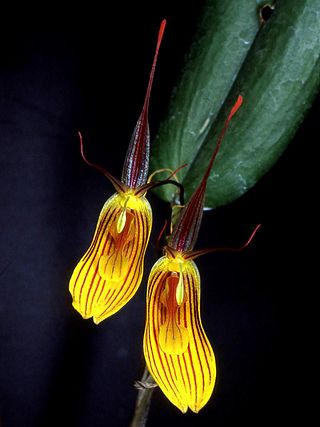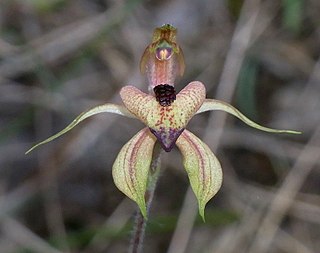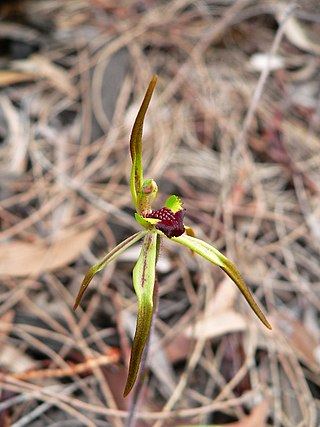
Restrepia, abbreviated Rstp in horticultural trade, is a small genus of 50 species in the orchid family (Orchidaceae), closely related to Pleurothallis. Named in honor of Don Jose Restrepo, it tends to be more showy than most other Pleurothallids. They are found primarily at higher altitudes in the cool, damp montane forests of the Andes and Venezuela, with some into Central America up to southern Mexico.
Restrepia chocoensis is a species of flowering plant in the family Orchidaceae. It is named for the Department of Chocó, Colombia, where it was discovered.

Restrepia muscifera, commonly known as the fly-carrying restrepia, is a species of orchid.

Restrepia falkenbergii, commonly called the Falkenberg's restrepia, is an epiphytic orchid, found at altitudes between 1,000 and 2,000 m in Colombia.
Caladenia argocalla, commonly known as white beauty spider orchid, is a plant in the orchid family Orchidaceae and is endemic to South Australia. It is a ground orchid which grows singly or in loose groups and has a single, hairy leaf and one or two white to greenish-white flowers on a wiry, hairy stalk. The total population is thought to be between 2,000 and 4,500 and it is classed as an "Endangered" species.
Caladenia atroclavia, commonly known as the black-clubbed spider orchid, is a plant in the orchid family Orchidaceae and is endemic to south-eastern Queensland. It is a ground orchid with a single hairy leaf and a pale greenish-cream coloured flower with dark purple clubs and red patches on the petals.

Caladenia cardiochila, commonly known as thick-lipped spider-orchid, fleshy-lipped caladenia and heartlip spider-orchid, is a plant in the orchid family Orchidaceae and is endemic to Victoria and South Australia. It is a ground orchid with a single hairy leaf and one or two yellowish-green, red-striped flowers on a thin, wiry stem.

Caladenia corynephora, commonly known as the club-lipped spider orchid, is a plant in the orchid family Orchidaceae and is endemic to the south-west of Western Australia. It has a single erect, hairy leaf and one or two greenish-yellow and red flowers which have a labellum with a club-like tip. It is the only Western Australian caladenia with a clubbed labellum.

Caladenia cruciformis, commonly known as the crucifix spider orchid, or red cross spider orchid, is a plant in the orchid family Orchidaceae and is endemic to a small area in Victoria. It is a rare ground orchid with a single, sparsely hairy leaf and a single dark red to crimson flower with blackish tips.

Caladenia gladiolata, commonly known as small bayonet spider orchid, smelly socks or simply bayonet orchid is a plant in the orchid family Orchidaceae and is endemic to South Australia. It is a ground orchid with a single hairy leaf and one or two yellowish or brownish flowers with red stripes and unusual tips on the sepals and petals.
Caladenia leptoclavia, commonly known as the thin-clubbed spider orchid, is a plant in the orchid family Orchidaceae and is endemic to New South Wales. It is a ground orchid with a single hairy leaf and a single pale cream-coloured to yellow flower with dark reddish stripes.

Caladenia phaeoclavia, commonly known as the brown-clubbed spider orchid, is a species of orchid endemic to New South Wales. It has a single, hairy leaf and a single light to dark green flower with red stripes and thick, brownish club-like tips on the sepals.
Caladenia sigmoidea, commonly known as the sigmoid spider orchid, is a species of orchid endemic to the south-west of Western Australia. It has a single erect, hairy leaf and usually only one red and cream-coloured flowers with an unusual S-shaped labellum.
Caladenia stellata, commonly known as the starry spider orchid, is a plant in the orchid family Orchidaceae and is endemic to south-eastern Australia. It is a ground orchid with a single, hairy leaf and usually only one greenish-cream flower with red markings.

Caladenia villosissima, commonly known as the hairy spider orchid, is a plant in the orchid family Orchidaceae and is endemic to Victoria. It is a ground orchid with a single densely hairy leaf and a single pale green flower with red stripes along the sepals and petals. It is a poorly known species and there is insufficient information about its distribution and abundance to determine whether or not it is endangered.

Caladenia wanosa, commonly known as the Kalbarri spider orchid, is a species of orchid endemic to the south-west of Western Australia. It has a single erect, hairy leaf and one or two cream-coloured flowers with red stripes. It is common but only in a restricted area of the state.

Pterostylis pedoglossa, commonly known as the prawn greenhood, is a species of orchid endemic to south-eastern Australia. There is a rosette of leaves at the base and flowering plants have a single white flower with green stripes, sometimes with a brownish tinge on the tip, and a long, thread-like labellum.

Pterostylis allantoidea, commonly known as shy greenhood, is a species of orchid which is endemic to the south-west of Western Australia. It has a large rosette of leaves at the base of a flowering spike and a single white flower with green or reddish-brown stripes.
Diuris unica is a species of orchid which is endemic to eastern Australia. It usually has only one grass-like leaf at its base and up to eight bright, lemon-yellow flowers with a few dark markings. It is similar to D. chrysantha but flowers much earlier than that species and has only a single leaf rather than two.

Corybas acuminatus, commonly known as the dancing spider orchid or helmet flower, is a species of terrestrial orchid endemic to New Zealand. It has a triangular, sharply pointed leaf and a small translucent, greenish-white flower with purple markings and with very long sepals. It is found on both the main islands of New Zealand and also some of the off-shore islands.













